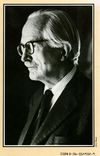Fear to Tread
Fear to Tread is a mystery–crime thriller by the British mystery writer Michael Gilbert, first published in 1953 by Hodder and Stoughton in England and by Harper & Brothers in the United States. Set mostly in London, it was his seventh novel in six years and built upon the favorable reputation he had achieved earlier with the well-received Smallbone Deceased and Death Has Deep Roots. It is one of numerous stories and novels by Gilbert presenting a gritty, realistic depiction of organized gangs, frequently directed by a deeply concealed mastermind who is not unearthed until the final pages.
Main character
Its main character is Wilfred Wetherall, a middle-aged, mild-mannered headmaster of "an understaffed, overpopulated secondary school for boys in the south-east of London." [1] To further emphasize the apparently unheroic nature of the protagonist, throughout the book the third-person, omniscient narrator refers to him as "Mr. Wetherall". Chief Superintendent Hazlerigg plays an important role in the book but does not appear until page 154 of the 223-page British edition.
Plot
The book's plot is the gradual discovery by Mr. Wetherall that even a number of years after the end of World War II there is a flourishing black market in London for rationed food and other items, most of them stolen by one gang or another and then "redistributed" for their profit to restaurateurs and catering services. The gangs responsible for these activities are directed by a well-concealed master criminal and all of them are totally ruthless when it comes to protecting their identities. Mr. Wetherall becomes more and more aware of the black marketing from dealing with both some of his youthful students and with his staff and their relatives. As he gets caught up in their developments, threats and warnings are increasingly directed at him. A deeply stubborn streak that refuses to let him be unfairly pushed around, as well as his innate sense of fair play, keep him getting further and further involved. At first he seeks allies from a powerful newspaper editor and then, at last, from Superintendent Hazlerigg.
Appraisal
In a long, admiring New York Times article about Gilbert by the mystery writer Amanda Cross she writes that:
His heroes fight without hope of reward, because they hate bullying; they honor, albeit with regret, the slow processes of democracy and law; they are loyal to those who have fought at their side, and they do not think trust a mug's game. In short, his characters embody the virtues of the class-ridden but romantic public school tradition.[2]
This perfectly sums up Mr. Wetherall and his battle with the underworld.
Characteristics
Characteristic of much of Gilbert's work over the next half-century is his use in this book of teen-aged boys as important characters—in this he is practically unique in the field: very few of his peers' works have any characters except adults. Also characteristic of his other works is the growing blackness he brings to the story as it progresses. What begins in a rather innocuous way becomes darker and grimmer as the events unfold in sometimes surprising ways. As one of his editors said after Gilbert's death in 2006, "He's not a hard-boiled writer in the classic sense, but there is a hard edge to him, a feeling within his work that not all of society is rational, that virtue is not always rewarded.".[3] Such is the case here.
Notes
- ↑ Mr. Wetherall also plays a small but vital role in the Inspector Petrella short story "Petrella's Holiday" that is collected in The Man Who Hated Banks.
- ↑ The New York Times, 9 September 1982 at [1]
- ↑ Douglas Greene of Crippen & Landrau, quoted in The New York Times, 15 February 2006
